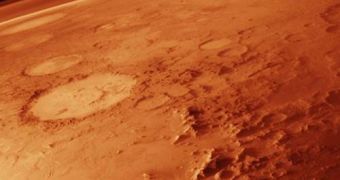A new scientific study, conducted by a NASA researcher, reveals the fact that microbes able to withstand the harsh conditions of the Earth's most challenging climates are no match for Martian habitats. In simulations conducted in the laboratory, where conditions on the surface of the Red Planet were mimicked to a great extent, the research team learned that extremophile bacteria, which can live in the Siberian permafrost with relative ease, get hammered out of existence on Mars.
According to Kennedy Space Center (KSC) Space Life Sciences lab microbiologist Andrew C. Schuerger, who also works at the University of Florida, it may be that the Martian environment is still simply too hard on any Earth-based organism. “Very seldom have microbes that grow well under cold or high salt conditions been subjected to Martian conditions,” he said, quoted by LiveScience. But the main threat to any potential microbial life is ultraviolet (UV) radiation, which has the potential to break up the organisms, and instill changes in their DNA patterns, destroying the strands.
The downside of the new study is that it pours some really cold water on those advocating the necessity of future Mars missions carrying detectors that could find life. The finds make it abundantly clear that an organism would have to be unlike anything we've seen thus far, in order to withstand the hardships of its home planet. But, at the same time, it offers NASA some insight into how to design future decontamination procedures for Mars missions, so as to prevent cross-contamination between bacteria hitching a ride on the spacecraft and any potential life that may exist on the planet.
“If we can find any of extremophilic terrestrial species that are capable of growth and replication under Martian conditions, it puts the search for life on Mars a bit closer to success. The research emphasizes the point that you're not going to automatically get protection from UV when embedded within salt deposits. Some salt encrustations might protect with just a few millimeters of salt, while others might need 5 to 10 centimeters,” Schuerger added. “I'm not overly worried that we're contaminating landing sights. I'm not suggesting that we relax planetary protection protocols, either, but current ones appear to be very good,” he concluded.

 14 DAY TRIAL //
14 DAY TRIAL //